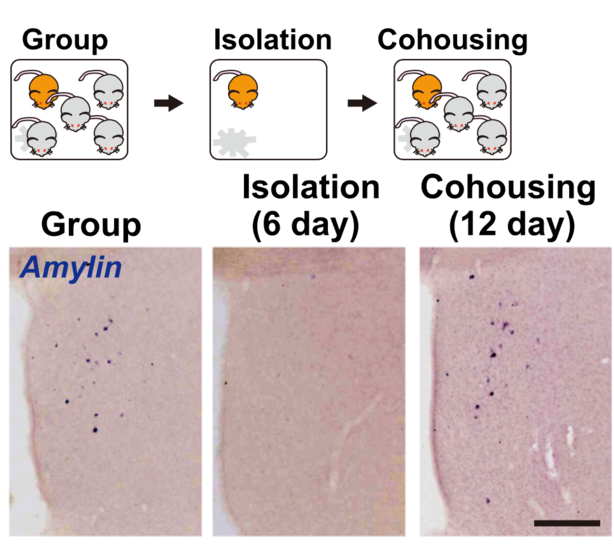It might not have been obvious until COVID struck, but social isolation is a significant stressor that can exacerbate risks of a range of diseases including dementia, depression, substance abuse, obesity, and even result in premature mortality. Yet, neural mechanisms that coordinate social behavior are unclear.
A new study exploring the neural basis of loneliness has identified a molecular mechanism that regulates social isolation in female mice: it’s called the amylin-calcitonin receptor (calcr) signaling pathway.
The findings are published in an article in the journal Nature Communications on February 8 (“Amylin-Calcitonin receptor signaling in the medial preoptic area mediates affiliative social behaviors in female mice“).

Earlier work by the senior author of the paper, Kumi Kuroda, PhD, scientist and team leader at the RIKEN CBS, showed maternal care in mammals is regulated by amylin-responsive neurons the central MPOA of the hypothalamus. The MPOA differs based on sex in nearly all species, including humans.

Examining amylin signaling during maternal care, Kuroda and her team noticed, amylin levels in female mice in the cMPOA decreased significantly if the mice were housed in isolation for six days and returned to normal levels after two weeks of being reunited with cage mates.
Kuroda said, “Amylin looks like the best molecular indicator of the social condition. It almost depletes from the cMPOA after a week of isolation. This is the most drastic response among brain molecules that respond to social isolation. Other molecules, such as the oxytocin receptor can respond to social isolation but these exhibit slower and milder changes.”
The researchers observed this decrease in amylin even when the mice were separated from cage mates by a divider with a fenced window within the same cage that prevented physical contact. This indicated female mice needed free physical contact with other mice to maintain amylin expression in the cMPOA.

The researchers eliminated the possibility that the observed reduction in amylin levels occurred due to other confounding factors such as boredom, general stress, physical contact with humans, or contact with other mice for defensive purposes, through carefully designed behavioral study protocols.
“We applied various non-social stimuli—palatable food, human cuddling to isolated mice, or stress induction to group-housed mice—confirming that amylin level indeed depends on isolation and not on other associated stimuli,” said Kuroda.
Using in situ hybridization experiments, the investigators found physical contact activated both amylin- and calcitonin receptor-expressing neurons which led to the recovery of amylin mRNA expression in the cMPOA.
The authors then used chemogenetics to selectively activate amylin-expressing neurons. This increased contact-seeking behavior in female mice. In contrast, knocking down amylin or the calcitonin receptor in the cMPOA in female mice decreased contact-seeking behavior.
The study required the investigators to develop a reproducible protocol to study and manipulate social conditions stringently that allowed them to measure the motivation of an isolated animal to seek out others. Before conducting isolation protocols, the scientists habituated the mice to a cage that included a partition or a divider with a fenced window. Replacing the solid partition with the fenced window allowed mice to see, hear, smell and make limited contact with others across the window but prevented free physical contact. The researchers note that female mice bit the bars of the window displaying contact-seeking behavior only when isolated on one side of the cage with their peers on the other side.
“Among other reported molecules, amylin is the one that responds the most to isolation and reunion, and itself facilitates contact-seeking behaviors,” says Kuroda. “With all these results, we became confident that amylin is the major player in the brain that is needed for sensing and seeking social contacts.”
The new finding provides molecular evidence in support of the long-held theory that social affiliation among adults evolves from parental care.
“Both parental care and female-female social contact depend on amylin and augment its expression,” Kuroda said. “This synergy might facilitate cooperative parenting, in which multiple females care for young together, as is observed in mice and humans.”
Kuroda and her team are currently testing the role of the amylin signaling pathway on social behavior in marmosets, in the hope of eventually identifying the neural basis of social contact and loneliness in humans.
“Unlike male mice, male marmosets show sociability as strong as females and therefore should serve as a better model for human sociability,” said Kurodad.



